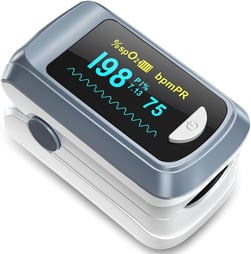
Short Of Breath? Let's Make That Better.
Discover effective strategies to improve that shortness of breath.
5/21/20253 min read
Have you ever been short of breath? Shortness of breath can stem from a variety of things. Maybe you have COPD, maybe you are recovering from pneumonia, or maybe you have just become deconditioned. No matter what the reason, feeling like you can't breath is a scary situation. It may increase your anxiety, and it may prevent you from doing things you love. So, what can we do to make this better?
Ever since you entered this world you have had the innate ability to breathe. Nobody had to sit you down after birth and teach you how to adequately supply oxygen to your body. So, it may seem weird all of a sudden to have someone tell you to think about and change how you are actually breathing. However, often times when we start to feel short of breath, our body reacts by breathing in a way that actually doesn't allow us to get in good, full breaths. So, changing our breathing pattern can be very helpful.
Sometimes we have a tendency to breathe in and out through our mouth, primarily using our chest accessory muscles, instead of taking nice deep breaths using our big diaphragm muscle. Maybe you have heard of the term, pursed lip breathing. This is a technique that can help improve your breathing. It helps keep airways open to allow for better exchange of oxygen and carbon dioxide in your lungs. It can also be quite calming if you are feeling anxious because you can't seem to "catch your breath." During pursed lip breathing you take slow, deep breaths in through your nose, and then out through your mouth. Medical professionals will use the term, "smell the flowers, and then blow out the candles." When doing this, you want to focus on good, long deep breaths in and out.
I have an exercise I love to teach my patients that really helps to understand this concept. I will post a video below in the resources section for you to watch and learn, but let me explain the general concept. If you place your hands just under your breast bone, with your middle fingers gently touching, when you take a nice deep breath in through your nose, your middle fingers should gently separate. Then, when you exhale slowly through your mouth, those fingers should come back together. If we are properly breathing using our diaphragm muscle, it causes our ribs to move upward and outward. You can watch your fingers while breathing and use this as a feedback tool to know if you are actually breathing using that diaphragm muscle properly. When you get that nice deep breath in, hold it for a few seconds, letting those lungs fill full of air and stretch out, before you slowly exhale. You can repeat this exercise a few times a day, about 5-10 times each, to start strengthening those breathing muscles and lungs.
A wonderful feedback tool to have on hand in your home if you experience shortness of breath is a pulse oximeter. I will post a link below for you to reference, but these are generally very inexpensive, less than $15. A pulse oximeter is named because it measures your heart rate (pulse) and your oxygen (oximeter). Generally speaking, you want to see your oxygen levels be above 90. If you place that pulseoximeter on your finger and see that your levels are below 90, you know you need to stop what you are doing, and take some of those good deep breaths in through your nose, and out through your mouth. If, on the other hand, you are feeling short of breath, but your oxygen is over 90, than you know you can keep pushing with whatever activity you are doing and build that endurance up! This simple feedback tool can help guide you with your daily activities, and reduce some anxiety when you may not be sure if that body is getting adequate oxygen. (Note: I will touch base on heart rate in a later blog)
A couple quick notes about the pulseoximeter, should you decide to invest in one.
Sometimes it can take a moment to read, so if you put it on your finger and the reading is super low, don't fret! Give it a moment to register.
If your hands are cold, it can struggle to register as well. Warming up your hands can help assure an accurate reading.
Nail polish can sometimes limit the reading of a pulseoximeter. I've found that turning it to the side of your finger, versus over the nail, can help it read better.
The index or middle finger is generally preferred for getting the best pulseoximeter reading due to having good blood circulation.
I have recommended to many of my patient's purchasing a pulseoximeter for their home to use as a feedback tool. Most all of them have found it to be very helpful. If you struggle with feeling short of breath, this may just be the tool for you. Use it in correlation with your daily exercises, and this new breathing exercise you learned today, and start to feel better about your daily endurance! There's no better time to start than now.
https://amzn.to/43fYUas (Amazon)


